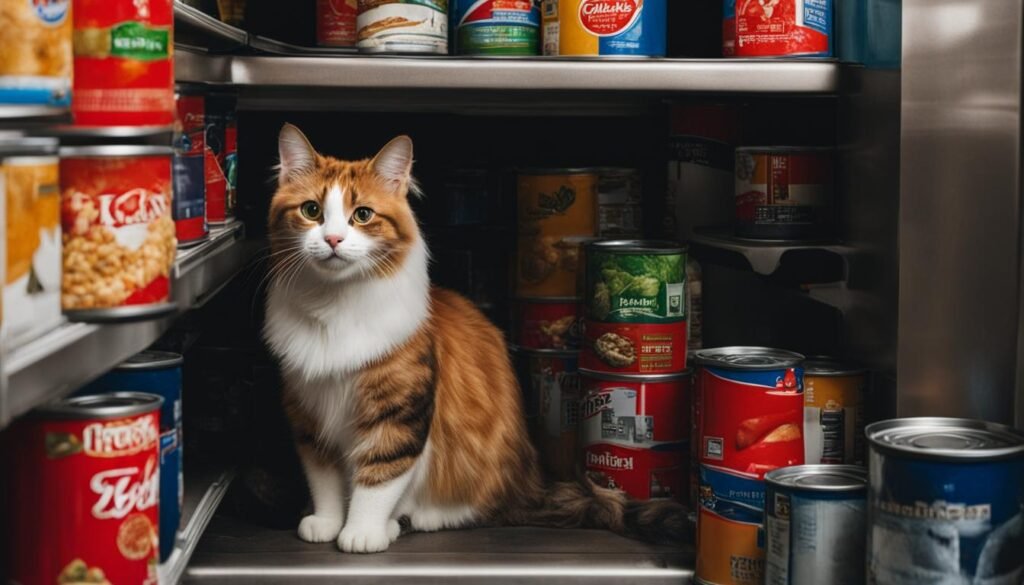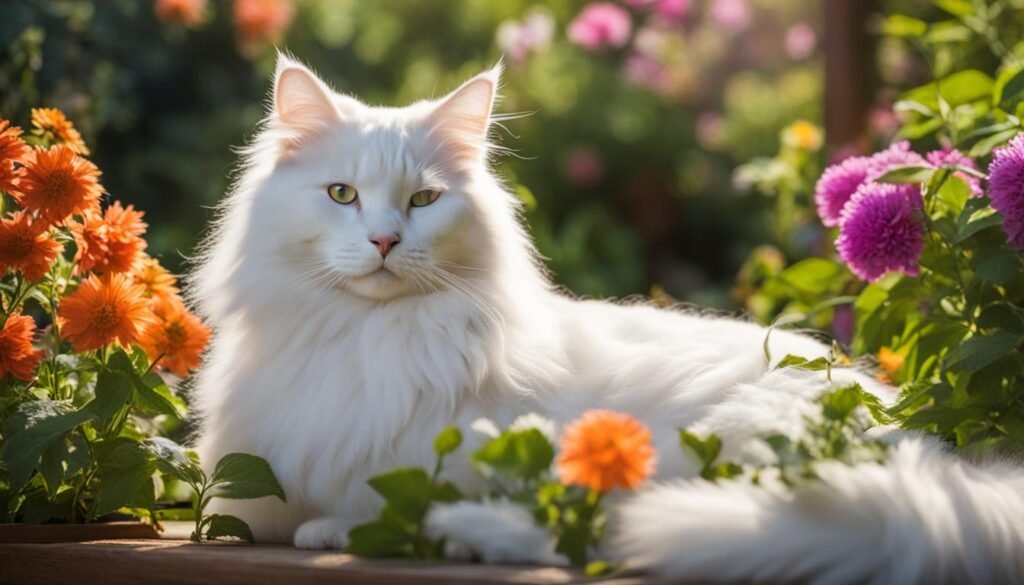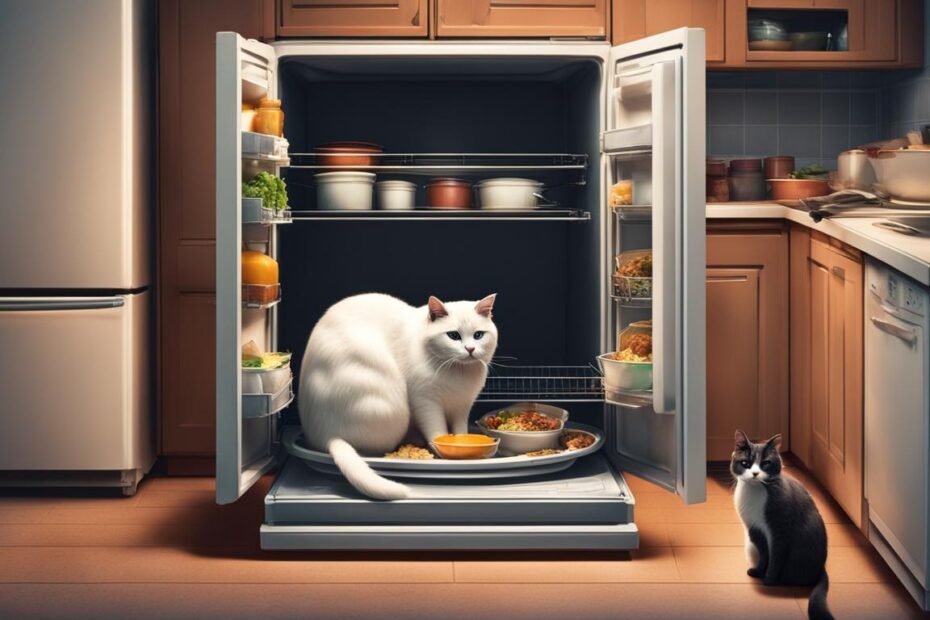Emotional eating in cats is a common issue that can lead to stress-related cat obesity. It is important to address this issue effectively in order to promote the emotional health of our feline companions.
Studies have shown that approximately 25% to 45% of domestic cats suffer from obesity, with emotional eating being a contributing factor. Cats may engage in emotional eating due to stress, boredom, or feelings of emptiness. By understanding the causes and triggers of emotional eating in cats, we can take steps to manage and prevent this behavior.
Key Takeaways:
- Emotional eating in cats can lead to stress-related obesity.
- Cats may engage in emotional eating due to stress, boredom, or feelings of emptiness.
- It is important to understand the causes and triggers of emotional eating in cats.
- Managing emotional eating involves providing a stimulating environment and alternative coping mechanisms.
- Emotional wellbeing is vital for the overall health and happiness of cats.
The Impact of Stress on Cat Eating Behavior
Stress can have a significant impact on the eating behavior of cats, leading to issues such as stress-related cat obesity and emotional eating. Just like humans, cats can experience stress in their daily lives, whether it’s due to changes in their environment, social interactions, or other factors. This stress can manifest in different ways, including changes in appetite and eating habits.
When cats are stressed, they may exhibit emotional hunger, which is a craving for specific comfort foods that is not related to physical hunger. This emotional eating can lead to overeating and unhealthy weight gain. Negative emotions like anxiety and depression can also stimulate eating behavior in cats, further exacerbating the issue.
It’s important for cat owners to recognize the signs of stress in their feline companions and address the underlying causes. By creating a calm and stress-free environment, providing enriching activities and outlets for stimulation, and offering affection and attention, cat owners can help alleviate stress and prevent emotional eating in their cats.
| Common Triggers of Emotional Eating in Cats | Impact on Eating Behavior |
|---|---|
| Stress | Increased appetite and overeating |
| Boredom | Mindless eating and overeating |
| Feelings of emptiness | Craving specific comfort foods |
“Understanding the impact of stress on cat eating behavior is crucial in addressing emotional eating and promoting better health for our feline friends.” – Dr. Emily Thompson, Veterinarian
Preventing Stress-Related Cat Obesity
Preventing stress-related cat obesity and emotional eating starts with identifying and addressing the triggers that lead to these behaviors. By keeping a food and mood diary, cat owners can track their cat’s eating habits and look for patterns or triggers that may be contributing to emotional eating. Common triggers may include changes in routine, social influences, or associations with food from childhood.
Once the triggers are identified, it’s important to create a routine and environment that minimizes stress and provides ample mental and physical stimulation for the cat. Feeding puzzles and interactive toys can help keep cats entertained and mentally stimulated, preventing boredom eating. Controlling portion sizes and providing a balanced diet will also contribute to maintaining a healthy weight and preventing emotional eating.
By understanding the impact of stress on cat eating behavior and taking proactive steps to address it, cat owners can help their feline companions live healthier, happier lives.
References:
- Burgess, E. A., & Barrows, D. F. (2011). The epidemic of feline obesity and diabetes mellitus. Journal of feline medicine and surgery, 13(10), 693-702.
- Heath, S., & Xia, Q. (2014). The influence of stress on body weight and body condition in domesticated cats. Journal of veterinary behavior, 9(6), 218-227.
- Quiles-Carrillo, L., Ramírez-Pérez, A., Pina-Aguilar, R. E., & Canseco-Rodríguez, A. (2019). The influence of stress on the eating habits and body condition of domestic cats. Journal of veterinary behavior, 31, 34-40.
Identifying Emotional Eating Triggers in Cats
Emotional eating in cats can be triggered by various factors, including boredom, stress, or feelings of emptiness. Understanding these triggers is essential in addressing and managing emotional eating behavior in our feline companions. By identifying the specific triggers that lead to emotional eating, we can implement effective coping mechanisms and prevent the negative consequences associated with this behavior.
One common trigger for emotional eating in cats is boredom. Cats are intelligent animals that thrive on stimulation and mental engagement. When they lack environmental enrichment and interactive play, they may turn to food as a source of entertainment. It is important to provide cats with a stimulating environment that includes toys, scratching posts, and opportunities for play to prevent boredom eating.
Stress is another significant trigger for emotional eating in cats. Changes in routine, such as moving to a new home or the addition of a new pet, can cause stress and lead to emotional eating behaviors. Cats may also experience stress due to social influences, such as conflicts with other pets or a lack of safe spaces. By identifying and addressing these stressors, we can help cats find alternative coping mechanisms and reduce their reliance on food for emotional comfort.
Coping Mechanisms for Emotional Eating in Cats
Implementing various coping mechanisms can help cats manage their emotions without resorting to emotional eating. Engaging in interactive play sessions with your cat can provide them with mental stimulation and an outlet for their energy. Additionally, providing them with food puzzles or interactive feeders can make mealtime more engaging and prevent mindless eating.
“Playing with your cat not only provides physical exercise but also strengthens the bond between you and your feline companion.”
Affection and attention also play a vital role in managing emotional eating in cats. Spending quality time with your cat, offering comfort, and providing a safe and nurturing environment can help alleviate their stress and reduce their reliance on food for emotional support.
By understanding the triggers of emotional eating in cats and implementing effective coping mechanisms, we can help our feline friends lead healthier and happier lives. Creating a stimulating environment, addressing stressors, and offering alternative outlets for emotions can reduce the reliance on food as a coping mechanism, promoting emotional well-being in cats.

Distinguishing Between Emotional and Physical Hunger in Cats
When it comes to understanding the eating behavior of cats, distinguishing between emotional and physical hunger is crucial. Emotional hunger in cats tends to come on suddenly and is often linked to specific comfort foods. Cats experiencing emotional hunger may exhibit mindless eating and continue consuming food even when they are full. Unlike physical hunger, emotional hunger is not located in the stomach but is experienced as a strong craving. It is important for cat owners to recognize the signs of emotional hunger and address them appropriately.
Physical hunger, on the other hand, comes on gradually and can be satisfied by eating until the cat is full. Cats experiencing physical hunger will typically exhibit more regular eating patterns and will stop eating once their hunger is satiated. By observing their cat’s eating behaviors and paying attention to the timing and intensity of hunger cues, owners can better distinguish between emotional and physical hunger.
To provide further insight into distinguishing between emotional and physical hunger in cats, let’s take a closer look at some key differences:
Emotional Hunger
- Comes on suddenly
- Craves specific comfort foods
- Mindless eating
- Continues eating even when full
- Not located in the stomach
Physical Hunger
- Comes on gradually
- Can be satisfied by eating until full
- Exhibits regular eating patterns
- Stops eating once hunger is satiated
Understanding the distinction between emotional and physical hunger in cats is essential for addressing emotional eating behaviors. By being mindful of these differences and providing the appropriate care and attention, cat owners can help their feline companions maintain a healthy relationship with food and overall emotional wellbeing.
| Emotional Hunger | Physical Hunger |
|---|---|
| Comes on suddenly | Comes on gradually |
| Craves specific comfort foods | Can be satisfied by eating until full |
| Mindless eating | Exhibits regular eating patterns |
| Continues eating even when full | Stops eating once hunger is satiated |
| Not located in the stomach |
“Understanding the distinction between emotional and physical hunger in cats is essential for addressing emotional eating behaviors.”
Promoting Healthy Eating Habits in Cats
When it comes to preventing emotional eating in cats and promoting healthy eating habits, there are several strategies that cat owners can implement:
- Provide a balanced diet: Ensuring that cats receive a nutritious and well-balanced diet is essential for their overall health. Consult with a veterinarian to determine the appropriate type and quantity of food for your cat’s specific needs.
- Control portion sizes: Overfeeding can contribute to obesity and emotional eating in cats. Measure and divide your cat’s daily food portion into several small meals throughout the day to help prevent excessive eating.
- Use feeding puzzles and enrichment activities: Engaging your cat in interactive feeding puzzles and providing enrichment activities can stimulate their minds and prevent boredom eating. These activities can also help cats associate food with mental engagement rather than emotional comfort.
- Create a stress-free environment: Cats are sensitive to their surroundings and can experience stress, which may trigger emotional eating. Provide a calm and stress-free environment for your cat by minimizing loud noises, maintaining a regular routine, and offering hiding spots or safe spaces.
- Encourage ample exercise and playtime: Regular exercise and playtime can help cats release pent-up energy and reduce stress levels. Dedicate time each day to engage your cat in physical activities such as interactive play sessions, chasing toys, or using puzzle toys that dispense treats.
By implementing these practices, cat owners can help their feline companions develop and maintain healthy eating habits, reducing the risk of emotional eating and ensuring their overall well-being.
Table: Tips for Promoting Healthy Eating Habits in Cats
| Tip | Description |
|---|---|
| Provide a balanced diet | Consult with a veterinarian to determine the appropriate type and quantity of food for your cat’s specific needs. |
| Control portion sizes | Measure and divide your cat’s daily food portion into several small meals throughout the day to help prevent excessive eating. |
| Use feeding puzzles and enrichment activities | Engage your cat in interactive feeding puzzles and provide enrichment activities to stimulate their minds and prevent boredom eating. |
| Create a stress-free environment | Minimize loud noises, maintain a regular routine, and offer hiding spots or safe spaces to reduce stress levels in your cat. |
| Encourage ample exercise and playtime | Dedicate time each day to engage your cat in physical activities such as interactive play sessions or using puzzle toys that dispense treats. |
Promoting healthy eating habits in cats is vital for their overall well-being. By following these tips and providing a nurturing environment, cat owners can help their feline friends develop a healthy relationship with food and prevent emotional eating.
Managing Emotional Eating in Cats
Coping with emotional eating in cats is a crucial part of ensuring their overall well-being and preventing stress-related obesity. By addressing the underlying causes and providing alternative coping mechanisms, cat owners can effectively manage emotional eating in their feline companions.
Creating a Safe and Stimulating Environment
One of the key aspects of managing emotional eating in cats is to provide them with a safe and stimulating environment. This includes offering plenty of interactive toys, scratching posts, and designated spaces for play and relaxation. Engaging in regular interactive play sessions with your cat can help them release built-up stress and emotions in a healthy way.
Using Food Puzzles and Enrichment Activities
Food puzzles and enrichment activities can be highly beneficial in managing emotional eating in cats. These provide mental stimulation and help distract cats from turning to food for comfort. Introducing puzzle feeders or hiding small portions of their meals in different areas of the house can keep them mentally engaged and prevent mindless eating.
Seeking Professional Guidance
If emotional eating in your cat persists despite your efforts, it may be helpful to seek guidance from a veterinarian or animal behaviorist. They can assess your cat’s specific needs and provide tailored advice on managing emotional eating. They may recommend behavior modification techniques, environmental changes, or even medication if necessary.
By implementing these strategies, cat owners can effectively manage emotional eating in their beloved feline companions, promoting their overall health and well-being.
| Common Strategies for Managing Emotional Eating in Cats | Benefits |
|---|---|
| Creating a safe and stimulating environment | – Helps cats release stress and emotions – Provides alternative outlets for emotional needs |
| Using food puzzles and enrichment activities | – Provides mental stimulation – Prevents mindless eating – Distracts cats from emotional eating |
| Seeking professional guidance | – Tailored advice from experts – Behavior modification techniques – Medication if necessary |
The Importance of Emotional Wellbeing in Cats
Emotional wellbeing is a vital aspect of a cat’s overall health and happiness. Just like humans, cats can experience a range of emotions, and their mental health plays a crucial role in their overall wellbeing. Taking care of a cat’s emotional needs is just as important as providing a balanced diet and regular veterinary care.
When a cat’s emotional wellbeing is compromised, it can lead to various behavioral and health issues. Cats that experience chronic stress or boredom may turn to emotional eating as a coping mechanism. This can result in excessive weight gain and associated health problems. By understanding and addressing our feline companions’ emotional needs, we can help them lead healthier and happier lives.
Recognizing Signs of Emotional Distress in Cats
It’s essential for cat owners to be able to recognize the signs of emotional distress in their feline friends. Some common indicators include excessive grooming, changes in appetite, withdrawal from social interactions, aggression, and litter box problems. These behaviors may signal that your cat is experiencing emotional turmoil and may need additional support and attention.
Creating a nurturing and stimulating environment is crucial for promoting emotional wellbeing in cats. Providing plenty of toys, scratching posts, and comfortable resting spaces can help alleviate boredom and provide outlets for natural behaviors. Additionally, spending quality time with your cat through interactive play and gentle grooming can strengthen the bond between you and help ease any emotional stress they may be feeling.
| Signs of Emotional Distress in Cats | Ways to Promote Emotional Wellbeing |
|---|---|
| Excessive grooming | Provide stimulating toys and scratching posts |
| Changes in appetite | Establish a consistent feeding routine |
| Withdrawal from social interactions | Engage in interactive play and gentle grooming |
| Aggression | Create a peaceful and stress-free environment |
| Litter box problems | Ensure a clean and accessible litter box |
By prioritizing your cat’s emotional wellbeing and addressing any issues that arise, you can help create a harmonious and fulfilling life for your beloved feline companion.

Conclusion
Emotional eating in cats is a common issue that can lead to stress-related obesity. To effectively manage emotional eating in cats at home, it is important to understand the causes and triggers behind this behavior. By providing a stress-free and stimulating environment, offering appropriate food and portion sizes, and addressing emotional needs in alternative ways, cat owners can help their feline friends maintain a healthy weight and emotional wellbeing.
Identifying the specific triggers that cause emotional eating in cats is crucial. Keeping a food and mood diary can help track these triggers and understand the patterns behind emotional eating. Once the triggers are identified, it becomes easier to implement strategies to prevent emotional eating, such as offering enrichment activities, engaging in interactive play, and using feeding puzzles.
Seeking guidance from a veterinarian or animal behaviorist can also be beneficial in managing emotional eating in cats. These professionals can provide valuable insights and recommendations tailored to the specific needs of each cat. Remember, emotional wellbeing plays a vital role in the overall health and happiness of cats. By addressing emotional eating and promoting healthy eating habits, cat owners can ensure their furry companions lead fulfilling lives.
FAQ
What is emotional eating in cats?
Emotional eating in cats refers to a behavior where cats eat in response to emotions rather than physical hunger.
What are the triggers for emotional eating in cats?
Emotional eating in cats can be triggered by stress, boredom, or feelings of emptiness.
How can I distinguish between emotional and physical hunger in my cat?
Emotional hunger tends to come on suddenly and craves specific comfort foods, while physical hunger comes on gradually and can be satisfied by eating until the cat is full.
What can I do to promote healthy eating habits in my cat and prevent emotional eating?
Providing a balanced diet, controlled portion sizes, and engaging in enrichment activities can help promote healthy eating habits in cats and prevent emotional eating.
How can I manage emotional eating in my cat?
Managing emotional eating involves addressing the underlying causes of stress or boredom, providing alternative coping mechanisms such as interactive play or food puzzles, and seeking guidance from a veterinarian or animal behaviorist if needed.
Why is emotional wellbeing important for cats?
Emotional wellbeing plays a crucial role in the overall health and happiness of cats. Understanding and addressing emotional eating is important for their mental and physical wellbeing.
